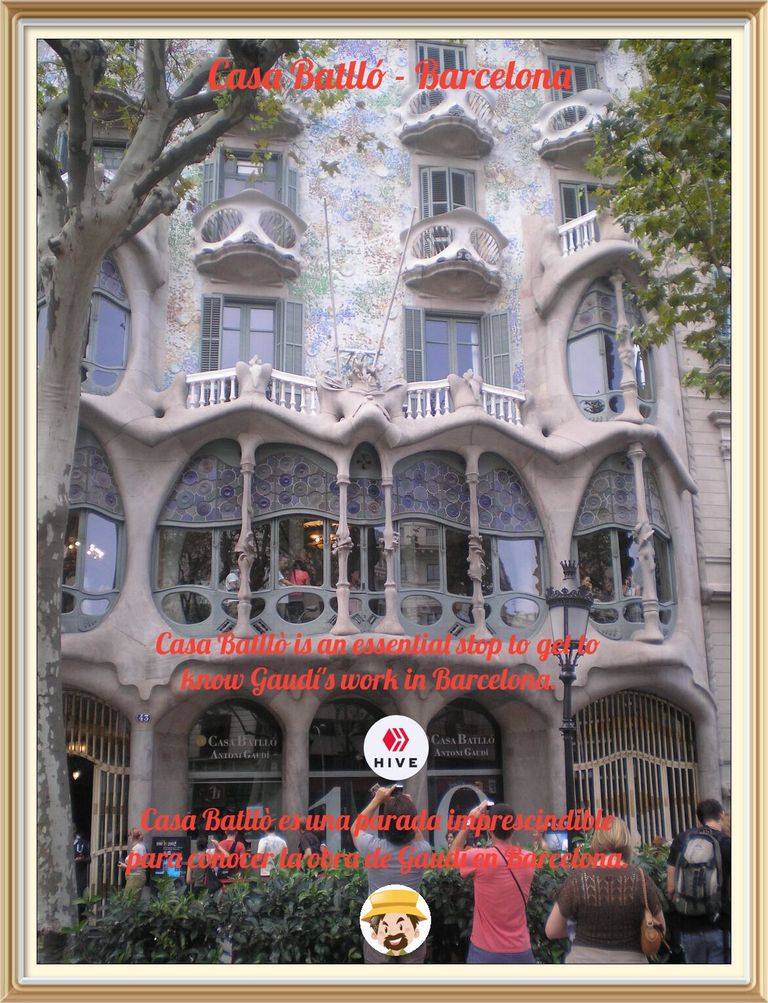
I needed some fresh air and tranquility after a hectic 2023. For this reason I decided - outside of the traditional holiday season - to take a few days of rest in contact with nature in the southern tip of the continent. Without cell phones or social networks or all that technology that has absorbed a part of our lives.
After having recharged my batteries, I am again with all the #blurtian friends of that platform to share my daily experiences, present, past and future.
Casa Batlló, considered one of Gaudí's most original creations in Barcelona, has been a UNESCO World Heritage Site since 2005.
A mixture of fantasy, nature and modernism, it stands on** Passeig de Gràcia (Passeig de Gràcia)**, totally restructured at the beginning of the 20th century by the famous Catalan architect in order to integrate it definitively into the city.
The building had originally been built at the end of the 19th century by Emilio Sala Cortés, one of Antonio Gaudí's teachers, and was acquired by Josep Batlló in 1903, a prominent Catalan businessman and owner of several industries that would eventually give it its name.
Batlló had originally commissioned Gaudí to completely demolish the building and build a new one. However, Gaudí managed to convince him to carry out a complete renovation while maintaining the structure of the building, a work that was completed in just three years, between 1904 and 1906.

The main modifications introduced by Gaudí were the façade, which is, today, the distinctive element of Casa Batlló, and a large part of the interior, which was not only transformed into a true work of art but was also given a great deal of functionality, more in keeping with modern times than with the past.
After the Second World War, Casa Battló changed hands several times but continued to retain its name until 1995, when it passed to the Bernat family, who began a complete restructuring of the building.
At the beginning of the new millennium, coinciding with the international year dedicated to Antonio Gaudí in 2002, the Casa Batlló was opened to the public for visits and cultural tours to appreciate the magnificence of the work of the brilliant Catalan architect.
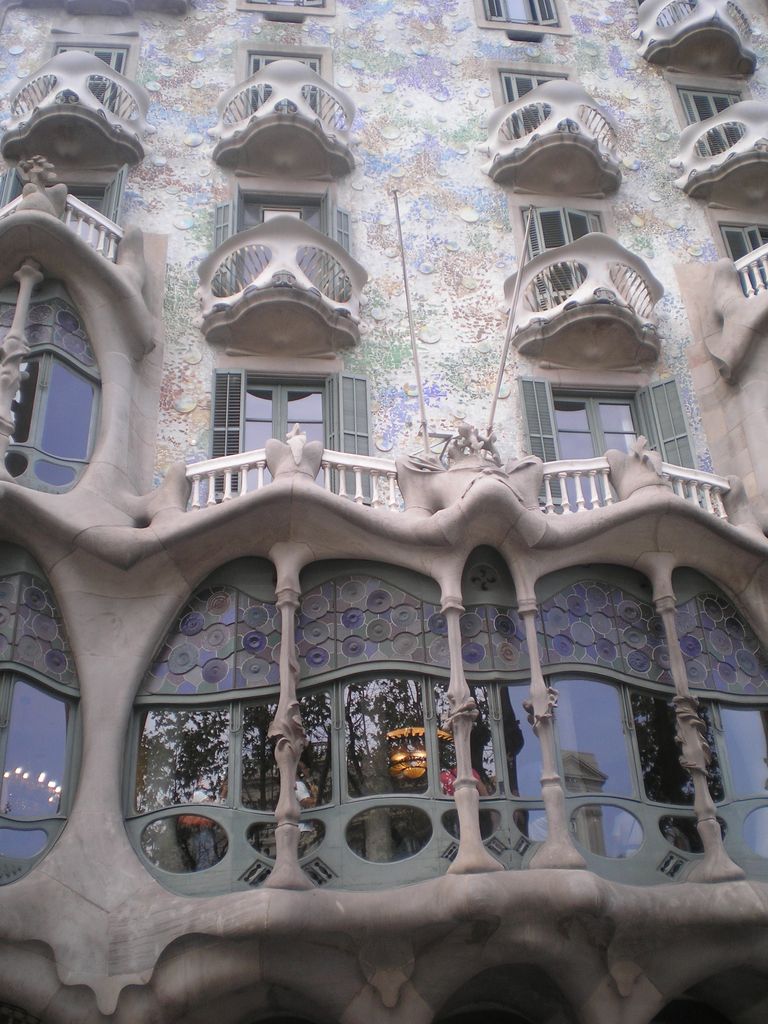
La Casa Batlló considerada como una de las creaciones más originales de Gaudí en Barcelona es Patrimonio Mundial de la Unesco desde el año 2005.
Mixto de fantasía, naturaleza y modernismo surge en el Passeig de Gràcia (Paseo de Gracia) totalmente reestructurado a inicios del siglo XX de la mano del célebre arquitecto catalán para integrarlo definitivamente a la ciudad.
El edificio había sido originalmente construído a finales del siglo XIX por Emilio Sala Cortés, uno de los profesores de Antonio Gaudí y fue adquirido por Josep Batlló en 1903 destacado hombre de negocios catalán y propietario de varias industrias que a la fin le daría su nombre.
En principio Battló le había encargado a Gaudí de demoler completamente el edificio y construir uno nuevo. Sin embargo Gaudí logró convencerlo de hacer una reforma integral manteniendo la estructura del edificio, obra que fue realizada en apenas tres años, entre 1904 y 1906.
Necesitaba un poco de aire fresco y tranquilidad luego de un agitado 2023. Por ese motivo decidí -fuera de la tradicional temporada de las vacaciones- tomarmo unos cuantos días de descanso en contacto con la naturaleza en el extremo sur del continente. Sin celular ni redes sociales ni todo esa tecnología que ha absorbido una parte de nuestras vidas.
Luego de haber recargado las pilas estoy de nuevo con todos los amigos #blurtians de esa plataforma para compartir mis vivencias diarias, presentes, pasadas y futuras.
Las principales modificaciones introducidas por Gaudí fueron la fachada que es, hoy en día, el elemento distinto de Casa Batlló y gran parte del interior que no solo fue transformado en una verdadera obra de arte sino que también fue dotado de una gran funcionalidad, más acorde con los tiempos modernos que con el pasado.
Después de la Segunda Guerra Mundial la Casa Battló cambió de dueño varias veces pero siguó conservando su nombre hasta que en el año 1995 pasa a la familia Bernat quien comienza un trabajo de reestructuración integral.
A partir del nuevo milenio, coincidiendo con el año internacional dedicado a Antonio Gaudí en el 2002 la Casa Batlló se abre al público para acoger visitas y tours culturales que permitan apreciar la magnificencia de la obra del genial arquitecto catalán.
The façade./ La fachada.
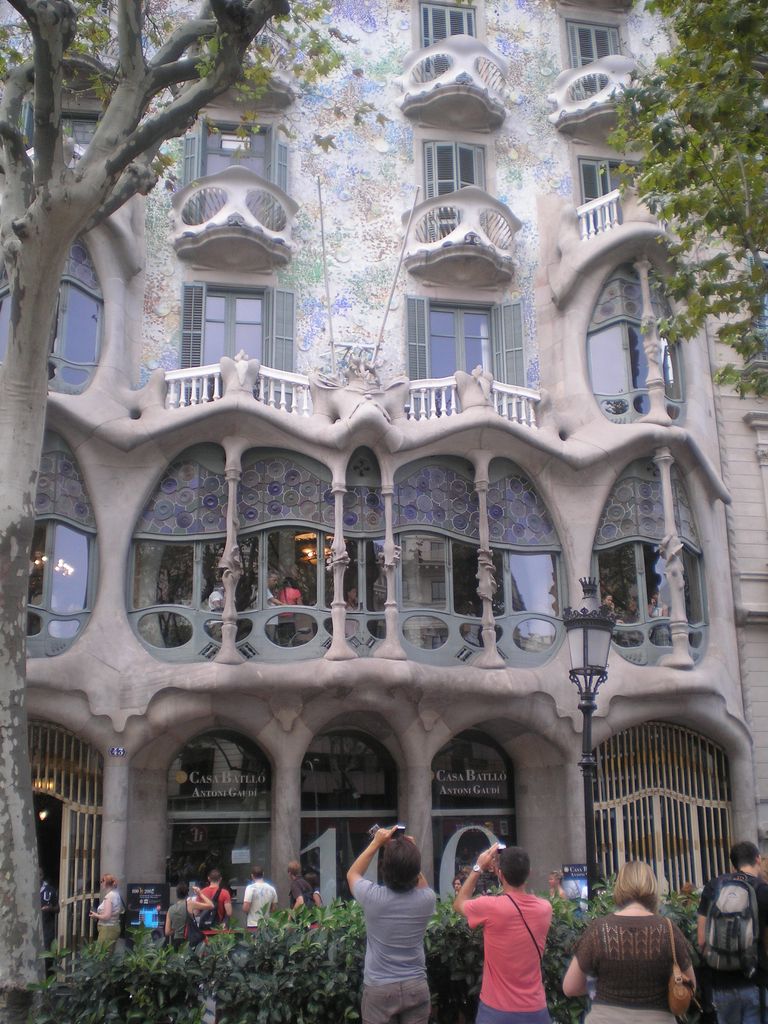
The originality of Gaudí's work is to have given Casa Battló a façade (at that time a stately style predominated, sometimes Victorian, sometimes Gothic, sometimes classical in the construction of buildings to denote the nobility of their origin) absolutely out of the canons of the time.
Built partly from recycled materials, on an undulating surface in which stone, glass and multicoloured ceramics are the real protagonists.
The sunlight in the early hours of the morning gives it a special colouring and a feeling of harmonious coexistence between fantasy, nature and art.
In fact, the undulations have a marine meaning that combines perfectly with the architectural exuberance and the decontextualised objects used in its construction, which combine perfectly with the artistic sense of Casa Battló.
Another of the predominant features of the façade are the columns on the first floors adorned with floral motifs and especially the balcony railings in the form of masks. But the curious detail is that they are not made of concrete but of wrought iron fixed to the wall at two anchor points that allow the railings to protrude outwards.
The roof of the building is no less spectacular. It resembles the back of an animal - probably the scales of a dragon in Gaudí's fantasy - at the base of which is a beehive on which rests a cross with four arms each pointing to the four cardinal points.
As in most of Gaudí's work, where religion, nature and art mingle, it is sometimes necessary to resort to one's own and other people's interpretations to find the meaning. Gaudí (almost) never declared what the meaning of his works was. Perhaps because a fantasy at the limit of the normal interpretation of ordinary people prevented him from doing so or explaining it.
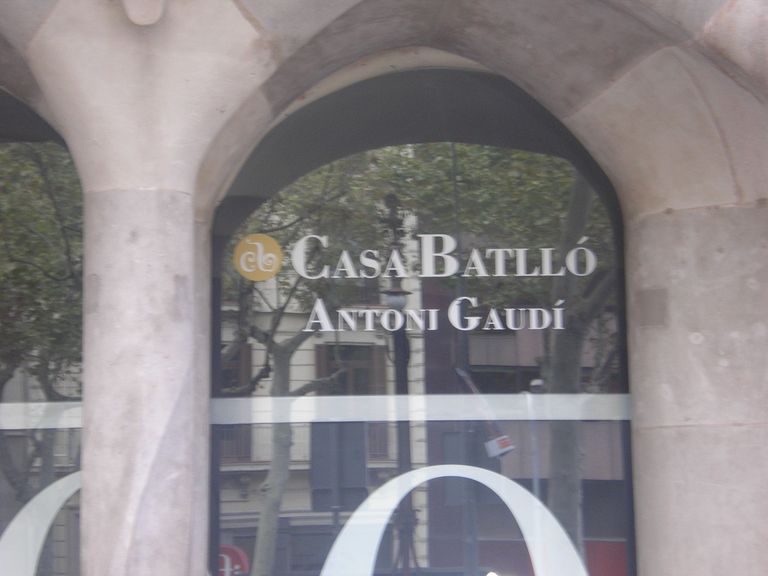
Some attribute the meaning of the roof to the legend of Sant Jordi, the patron saint of Catalonia (according to which he slays the dragon that threatened the city), but these are all suppositions and there is nothing written by Gaudí to certify it.
Another striking detail is that many aspects of the façade and columns of Casa Battló have bony forms decorated with floral motifs.
Many of the current views of Gaudí's works, and in particular Casa Battló, are due to statements by another eccentric Catalan genius, Salvador Dalí, who declared that "Gaudí has built a house according to the shapes of the sea, representing the waves on a calm day".
Another characteristic of Antonio Gaudí is that he directed the construction work from the outside, without precise plans, as was his custom. This meant that the work was, until the end of its construction, a real unknown.
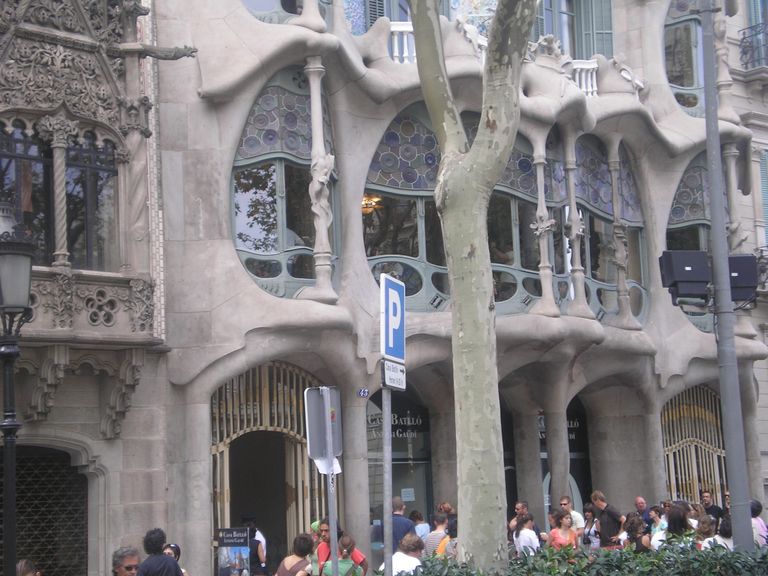
La originalidad de la obra de Gaudí es haber dotado a Casa Battló de una fachada (en esa época predominaba un estilo señorial, a veces victoriano, a veces gótico, a veces clásico en la construcción de los edificios para denotar la nobleza de su origen) absolutamente fuera de los cánones de esa época.
Construída en parte con materiales reciclados, sobre una superficie ondulada en la cuál la piedra, el vidrio y la cerámica multicolor son los verdaderos protagonistas.
La luz del sol en las primeras horas de la mañana le da una coloración especial y una sensación de armónica convivencia entre la fantasía, la naturaleza y el arte.
De hecho las ondulaciones tienen un significado marino que se conjuga perfectamente con una exhuberancia arquitectónica y objeto descontextualizados usados en su construcción que se conjugan perfectamente con el sentido artístido de Casa Battló.
Otra de las características predominantes en la fachada son las columnas en los primeros pisos adornadas con motivos floreales y especialmente las barandas de los balcones en forma de máscaras. Pero el detalle curioso es que no están construídas en cemento sino en hierro forjado fijado al muro en dos puntos de anclaje que permiten a las barandas de sobresalir al externo.
El tejado del edificio no es menos espectacular. Simila el lomo de un animal -probablemente las escamas de un dragón en la fantasía gaudiana- en cuya base se encuentra una colmna sobre la que se apoya una cruz de cuatro brazos dirigidos cada uno de ellos a los cuatro puntos cardinales.
Como la mayor parte de la obra de Gaudí donde se mezclan la religión, la naturaleza y el arte en necesario acudir a veces a interpretaciones propias y ajenas para hallar su significado. Gaudí (casi) nunca declaraba cuúl era el significado de sus obras. Tal vez porque una fantasía al límite de la normal interpretación de las personas comunes le impedía hacerlo o explicarlo.
Algunos atribuyen el significado del tejado a la leyenda de Sant Jordi que es el patrón de Cataluña (según la cuál mata al dragón que amenazaba la ciudad) pero son todas suposiciones y no hay nada escrito dejado por Gaudí que lo certifique.
Otro detalle que forma la atención es que muchos aspectos de la fachada y columnas de Casa Battló tienen formas óseas decoradas con motivos floreales.
Muchas de las actuales de las obras de Gaudi, y en particular de Casa Battló, se deben a declaraciones de otro genio excéntrico catalán, Salvador Dalí declarando que “Gaudí ha construido una casa según las formas del mar, representando las olas en un día de calma."
Otra característica de Antonio Gaudí es que dirigía las obras de construcción desde el exterior, sin planos precisos, como era su costumbre. De manera tal que la obra era, hasta el final de su construcción, una verdadera incógnita.
The interior. / El interior.
Although much praise goes to the façade, which can be seen by thousands of people every day without paying the entrance fee, the interior is only accessible to those who have bought a ticket.
The interior is no less spectacular and Gaudí brought in the best craftsmen of the time in wrought iron (one of his weaknesses), wood, stone, tiles and multicoloured ceramics to create a colourful unison inside Casa Batlló.
The reflections of the glass panes resemble waves of water that come and go. The handrails are ergonomically shaped, the functionality is absolute and the entire interior is suddenly transformed into a total, integral work of art, where the dominant elements are design, colour, form, space and light.
As a final curious fact, when Casa Battló was built in Barcelona there was no electricity and when Gaudí took charge of the remodelling he tried to ensure that the whole house reflected as much natural light as possible from the inside.
A pesar de que muchos elogios se los lleva la fachada que puede ser vista por miles de personas a diario sin pagar la entrada, el interior en cambio es accesible solo a quien han adquirido el boleto.
El interior no es menos espectacular y Gaudí trajó en su momento con los mejores artesanos de la época en hierro forjado (una de sus debilidades), madera, piedras, azulejos y cerámicas multicolores que crearon un unierso de color dentro de Casa Batlló.
El reflejo de vidrios similan ondas de aguas que van y vienen. Los pasamanos tienen formas ergonómicas, la funcionalidad es absoluta y todo su interior se transforma de repente en una obra de arte total, integral, donde los elementos dominantes son el diseño, el color, la forma, el espacio y la luz.
Como dato curioso final cabe destacar que cuando se construyó Casa Battló en Barcelona no había luz eléctrica y cuando Gaudí se hizo cargo de la remodelación trató que toda la casa reflejara desde su interior toda la luz natural posible.
Until our next tour, thank you for reading and sharing my content!
Hasta nuestro próximo recorrido, gracias por leer y compartir mis contenidos!
Crossposting / Posteo cruzado.
These images have been obtained in the European summer of 2018 before the ravages caused by the Covid-19 pandemic at the beginning of 2019. They have probably been published in other media that are obviously my property or used in sponsored posts published on my blogs/web at the request of European marketing agencies I work with in Italy, Spain, France, the United Kingdom and other countries.
Estas imágenes han sido obtenidas en el verano europeo de l 2018 antes de los estragos causados por la pandemia del Covid-19 a inicios de 2019. Han sido probablemente publicadas en otros medios que son obviamente de mi propiedad o utilizados en posts patrocinados publicados en mis blogs/web a pedido de agencias de marketing europeas con las que trabajo en Italia, España, Francia, Reino Unido y otros países.*
| Blogs, Sitios Web y Redes Sociales / Blogs, Webs & Social Networks | Plataformas de Contenidos/ Contents Platforms |
|---|---|
| Mi Blog / My Blog | Los Apuntes de Tux |
| Mi Blog / My Blog | El Mundo de Ubuntu |
| Mi Blog / My Blog | Nel Regno di Linux |
| Mi Blog / My Blog | Linuxlandit & The Conqueror Worm |
| Mi Blog / My Blog | Pianeta Ubuntu |
| Mi Blog / My Blog | Re Ubuntu |
| Mi Blog / My Blog | Nel Regno di Ubuntu |
| Red Social Twitter / Twitter Social Network | @hugorep |
| Blurt Official | Blurt.one | BeBlurt | Blurt Buzz |
|---|---|---|---|
 |  |  |  |

Upvoted. Thank You for sending some of your rewards to @null. Read my last posts to make sure that BLURT burning is profitable for you. Before using this bot please make sure your account has at least 100 BP. Get more BLURT:
@ mariuszkarowski/how-to-get-automatic-upvote-from-my-accounts@ blurtbooster/blurt-booster-introduction-rules-and-guidelines-1699999662965@ nalexadre/blurt-nexus-creating-an-affiliate-account-1700008765859@ kryptodenno - win BLURT POWER delegationNote: This bot will not vote on AI-generated content
Thanks!!!!
Hi @hugo1954, great news! Your content was selected by curators @nalexadre, @ten-years-before to receive a special curation from BeBlurt 🎉 Don't hesitate to upvote this comment as the curators will receive 80% of the rewards for their involvement.
👉 What can you expect for 2024 on Blurt?
Win 85% rewards with myDelegation
Thanks for the support received @beblurt.